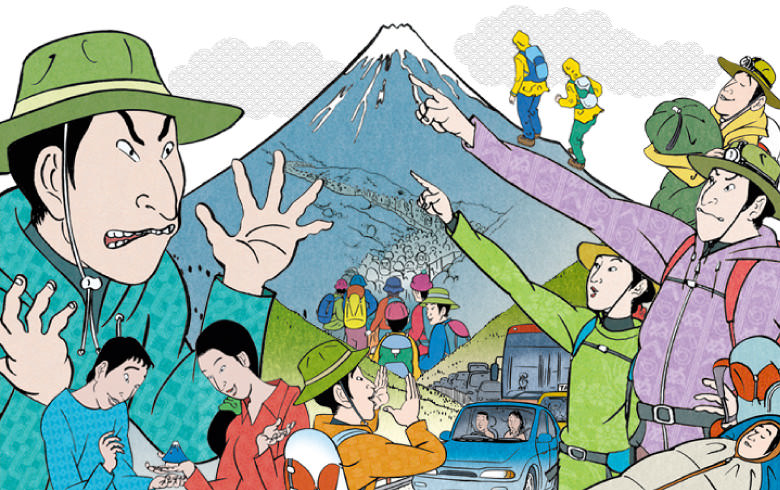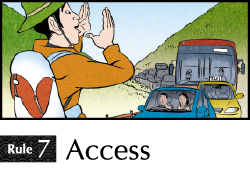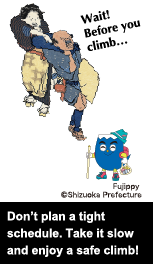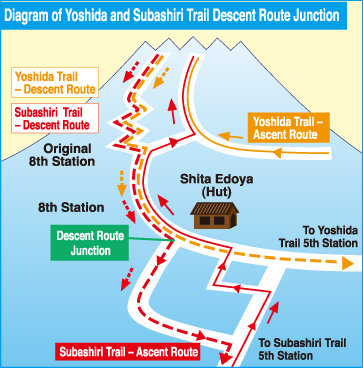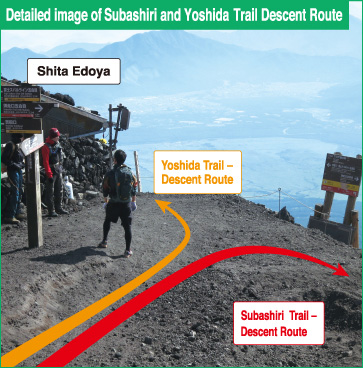Countless amateur mountaineers climb Mount Fuji every year. Just because the summit is visible from the foothills, however, does not mean that getting there is easy. Mount Fuji is Japan’s highest peak, after all, and climbers should be fully prepared both physically and mentally. Here are seven safety rules to keep in mind when climbing Mount Fuji.
Private Vehicle Traffic Restriction Dates in 2023
■ Fujinomiya Trail entrance: Sixty-three days
July 10(Mon.) 9:00 a.m. - Sept. 10(Sun.) 18:00 p.m.
■ Subashiri Trail entrance: Fifty-one days
July 14(Fri.) 12:00 p.m. - Aug. 27(Sun.) 12:00 p.m.
Sept. 1(Fri.) 12:00 p.m. - Sept. 3(Sun.) 12:00 p.m.
Sept. 8(Fri.) 12:00 p.m. - Sept. 10(Sun.) 12:00 p.m.
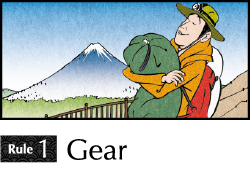
Always check your gear before starting an ascent. It's important to make sure that no old piece of equipment is broken. Mt. Fuji is over 3,000 meters high, and sudden changes in weather are common. Take into account the risks of an unexpected delay, and see to it that your gear is in perfect order.
Q&A Gear
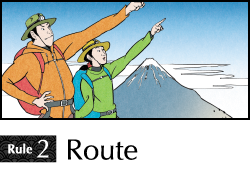
Four trails lead to the summit of Mt. Fuji, and each has a separate starting point and trailhead. The trails are color coded, so remember your color and be sure to follow the correct trail. Study each of the trails beforehand and choose the one best suited to your physical strength.
Video Guide
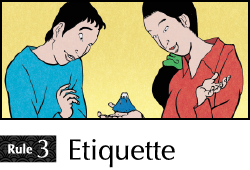
Mt. Fuji and much of the foothills are part of the Fuji-Hakone-Izu National Park and designated as a Special Place of Scenic Beauty and a Historic Site. Certain acts are prohibited, such as taking away plants, animals, lava, and rocks, pitching tents, and making fires. Please mind your manners.
Q&A Etiquette
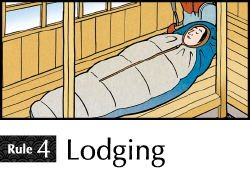
Huts on Mt. Fuji run at and above the 5th Station on each trail, as a rule only during climbing season. It's a good idea to rest at an altitude suited to your physical strength and replenish your energy to reach the summit. Check business hours beforehand and always make a reservation.
Q&A Lodging
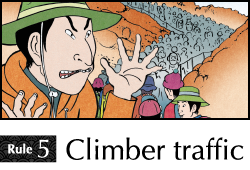
Mt. Fuji attracts the largest crowds after the rainy season, from late July through August. Weekends and the Obon holidays are especially busy, and the trails can overflow with climbers. Avoid these peaks to climb at your own pace or enjoy a quiet view of the sunrise from the summit.
Aroid crowding & climb Mt.Fuji safely & in comfort.
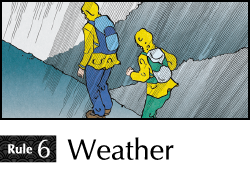
Mt. Fuji is an isolated peak of over 3,000 meters with severe weather year round. Conditions at the summit differ greatly from the foothills and the 5th Station. Sudden changes in weather are also common, and temperatures at the summit can dip below freezing even in midsummer. Always check the forecast before taking off on a climb.
Q&A Mental preparedness

When is the start and end of the climbing season?
The climbing season differs each year and by trail.
In 2019:
• Fujinomiya Trail, Gotemba Trail, Subashiri Trail: July 10 - September 10
• Yoshida Trail: July 1 - September 10
Depending on the conditions on Mt. Fuji, such as the amount of snow remaining, traffic may be restricted in certain sections of the trails and the opening of mountain huts may be delayed. Always collect information before planning your climb.
What is the recommended plan for climbing Mt. Fuji?
The recommended plan is one night, two days.
• Standard one-night, two-day plan
Day 1: Climb to the 7th Station or 8th Station >> Nap at a mountain hut
Day 2: Climb to the summit before dawn and watch the sunrise >> Tour the eight peaks around the crater >> Descend
• Sleep-in one-night, two-day plan
Day 1: Climb to the 7th Station or 8th Station >> Nap at a mountain hut
Day 2: Watch the sunrise at the mountain hut >> Climb to the summit >> Descend
* Mt. Fuji is crowded on weekends, and it may be impossible to reserve a hut. To set your own pace, plan your climb on weekdays.
How fast should I walk?
As slow as a turtle.
If you walk at the same speed as a stroll around the neighborhood, you will soon run out of breath. Maintain a steady breathing rhythm and heart rate. The rule of thumb is to walk at the pace of a turtle. Not only does it fend off fatigue, it also helps your body adjust naturally to the altitude.
How do I walk with the least exertion?
Take small strides and grip the ground with the entire shoe sole.
The trails of Mt. Fuji are strewn with lapilli and pebbles. It is easy to slip if you walk with large strides and the heels lifted. Losing and regaining balance consumes energy and exhausts you with each step. Take small strides and grip the ground with the entire shoe sole. In the end, this will help you climb faster.
What is the best way to take breaks?
Listen to your body and take long or short breaks as needed.
Time your breaks according to your physical condition. If you have walked too fast and begin to pant, take a break of 1 or 2 minutes on your feet. Should you decide to rest for longer than 5 minutes, use that time wisely-replenish your energy with water and a snack, use the toilet, and do stretches.
Preventing and treating altitude sickness
What is altitude sickness?
A condition caused by shortage of oxygen in the body.
The higher the altitude, the lower the oxygen concentration in the air, and the lower the oxygen supply in the body. The various symptoms caused by this shortage of oxygen are called altitude sickness.
What are the symptoms of altitude sickness?
Common symptoms are fatigue, lethargy, and headache.
Symptoms vary from one climber to the next. Mild symptoms include fatigue, lethargy, and headache. The shortage of oxygen supply causes physical imbalance, which may lead to dehydration and anomaly of the circulatory system. Altitude sickness should not be taken lightly. Cerebral edema, or swelling of the brain with fluid, is a serious symptom that can be fatal.
How can I prevent altitude sickness?
A condition caused by shortage of oxygen in the body.
1. Plan a loose schedule.
Rushing up and down Mt. Fuji in one day takes a heavy toll on the body and increases the risk of altitude sickness. Plan a loose schedule including one or more nights at a mountain hut. Getting plenty of sleep and avoiding alcohol intake on the day before your climb is also a good measure of prevention.
2.Adjust your body to the altitude at the 5th Station.
Rest for one or two hours at the 5th Station before embarking on your climb. This will help your body adjust to the altitude and reduce the risk of altitude sickness.
3.Walk slowly and take short breaks.
Walk at a slow, conversational pace, as this will naturally help you breathe more deeply. Also, take breaks at regular intervals. For example, climb for 25 minutes and rest for 5 minutes, or climb for 50 minutes and rest for 10 minutes.
4.Rehydrate frequently.
Drink water and urinate frequently throughout your climb. Aiding metabolism is an effective measure against altitude sickness. It is not safe to avoid water so as to save time on toilet breaks.
5.Practice diaphragm breathing.
To inhale a maximum of oxygen, exhale completely from the diaphragm. Diaphragm breathing is also said to be effective for relaxing the mind, controlling rises in blood pressure, and enhancing brain activity.
What should I do if I develop altitude sickness?
The best treatment is to descend to lower altitudes.
Altitude sickness is potentially life threatening. Stop climbing and get off the mountain as soon as possible.
Q&A Gear

How much cash should I carry?
About 15,000 yen including many 100 yen coins.
Toilets on Mt. Fuji require a fee. It is safest to have plenty of change on hand, particularly 100 yen coins. Food and drinks sold at mountain huts cost more than at ground level, since they include the cost of transportation. Climbers are recommended to carry some extra cash.
Expenses
Mountain hut accommodation: 8,000-9,000 yen
Pay toilets: 1,200-1,500 yen (200-300 yen per use)
Bottled drinks: 500-1,000 yen (400-500 yen per bottle)
* Depending on your plans, you will also need cash for meals, souvenirs, offerings at shrines, and collecting branding-iron stamps on your wooden hiking stick.
Total: 15,000-20,000 yen
Should I use sun protection?
Sun protection is essential at high altitudes.
UV rays are stronger on a high mountain than at ground level. Sun protection is essential. Sunscreen and sunglasses are a must. Sunscreen will wash away with sweat, so reapply frequently. Sunglasses will not only block the bright light but also prevent the cornea from absorbing UV rays, which stimulates melanin production and darkens the skin. Wraparound-style sunglasses are most effective.
What should I wear?
Clothes that keep you warm.
Just because the climbing season is in summer does not mean you can dress lightly. Temperatures at the summit are around 6ºC (43ºF), equivalent to midwinter in Tokyo. In rain or wind it will feel even chillier, and climbers should dress accordingly. Think winter clothes-down, fleece, gloves, and a knitted cap. Rainwear is also recommended, as are waterproof, breathable trekking boots to keep your feet warm.
How much water should I carry?
Start your climb carrying 1 liter. When you run out, replenish your supply at a mountain hut.
A one-night, two-day climb will require 2 to 3 liters of water. This is a huge supply to carry in your backpack. Start your climb with about 1 liter, and when you run low, buy more at a mountain hut along the way. It is not safe to avoid water so as to save time on toilet breaks. Beware of dehydration, as it increases the risk of developing altitude sickness.
What is the best way to consume food and drink during the climb?
Consume small amounts at a time during every break.
Replenish your energy at short intervals throughout your climb. You lose strength from climbing and minerals from sweating. It is a good idea to snack on candy or chocolate during every break.
Q&A Etiquette

Uphill traffic or downhill traffic-which has the right of way?
Uphill traffic.
On narrow trails, as a rule the person going uphill has the right of way. That said, show the courtesy to yield to oncoming traffic whether you are ascending or descending.
Any tips for crowded trails?
Do not force ahead of others.
Trails can get congested during peak hours of the summer climbing season. Overtaking others is dangerous, especially at night, as it may force you off the trail and cause you or loose stones to fall.
On which side of the trail should I walk?
Stay as close as possible to the inside of the trail, along the slope.
Walking along the trail's free edge can cause loose stones to fall and hit climbers below. Stay as close as possible to the inside of the trail, along the slope. If you do let loose stones fall, yell and warn others around you.
What is proper etiquette around mountain huts?
Keep the noise down.
At night, climbers are sleeping in mountain huts and replenishing their energy. Keep the noise down when taking a break near a mountain hut.
Can I touch animals?
Stay away from bird and mammal nests.
Wildlife Protection Areas are established in Mt. Fuji's trail areas to conserve birds and mammals, and encourage reproduction. Even if you find a nest, stay away.
Q&A Lodging

Do mountain huts require a reservation?
Mountain huts do get full. Always make a reservation.
Many mountain huts are full on weekends. Always make a reservation. Likewise, call the mountain hut in the event you cannot keep your reservation.
What is it like to sleep in a mountain hut?
Generally, you sleep side by side with others in a large room.
Unlike hotels and ryokan inns, mountain huts are designed purely for sleeping and resting. The average hut accommodates climbers in a large room with no partitions. Some have bunk beds with curtains. If you are likely to feel uncomfortable in this setting, it is a good idea to carry an eye mask and ear plugs.
Where do I change in a mountain hut?
You change in the toilet or in your futon bedding.
Mountain huts are not equipped with a dressing room, bathroom, or washroom. You change in the toilet or in your futon bedding. This is not very convenient for women. Women will need to be creative. Ask your friends for help to make a blind spot, for example.
What products and services are available at mountain huts?
Drinking water, mementos of your visit, and branding-iron stamps for your wooden hiking stick.
Snacks and drinks are available. Mountain huts with a diner serve light meals. A popular service is branding-iron stamps for your wooden hiking stick (200-300 yen).
Can I charge my cell phone at a mountain hut?
No, you cannot.
Electricity is limited at mountain huts, as they use an in-house power generator. Charging services are not available for cell phones, digital cameras, and other electronic equipment. Climbers are asked to carry their own battery charger.
